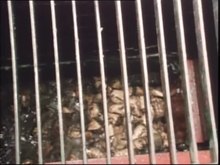Beet syrup
Sugar syrup (also turnip tops , the Rhineland Sehm or Siepnaat , in the Eifel Schlachmundes , in Wiesbaden slide , in Hanover Stips , formerly Wottelkrut (root herb), in Braunschweiger Land beet juice , the former Pomerania Kreude ) is made from the sap of sugar -derived syrup .
The syrup is produced without the use of additives by thickening the juice pressed from the cooked beet pulp. It has an evenly dark brown color, is viscous and tastes spicy and sweet.
Manufacturing
Making sugar beet syrup is similar to the first steps in making sugar . However, while in the sugar production targeted by precipitation of other components and crystallization , the sucrose is extracted, is extracted all the soluble materials of the beet in the production of sugar syrup. This juice is filtered and further boiled down until a syrup with a minimum dry matter of 78% is produced, which is sufficiently spreadable at 18 ° C.
Mixtures with apple syrup are also made as apple-beet syrup (also called apple-beet cabbage or mixed cabbage).
use
Sugar beet syrup is mainly used in the regions of sugar beet cultivation as a sweet spread , as a baking and cooking ingredient e.g. B. for pumpernickel in Westphalia , for sauces (to Rhenish sauerbraten ) and as an accompaniment to potato pancakes , pickert or panhas . Other trade names are beet cabbage, beet juice, beet syrup, sugar beet herb or sugar beet juice.
The name Stips or Stipps came about after the Second World War, when sugar beet syrup was a cheap, tasty and nutritious spread. It was consumed in such a thin liquid that it could not be spread on bread, but rather had to be dipped into the bread ("dipped in").
Nutritional values
Average nutritional information based on 100 g of syrup:
- Energy: 1,267 kJ (299 kcal)
- Protein: 2.3 g
- Carbohydrates: 69 g (of which 66 g sugar)
- Fat: <0.1 g
- Iron: 13 mg
- Magnesium: 90 mg
The values are subject to the usual fluctuations for natural products . The iron content of the syrup depends, among other things, on the weather conditions during the growth of the sugar beet and the nature of the soil. The sugar beet harvest or beet campaign lasts from around the beginning of October to mid-December. During this time the sugar beet syrup is produced for an entire year.
Chemical composition
- Dry matter: at least 78%
- Total acid: approx. 0.6%
- Ash: approx. 1.5%
- pH value (1: 2 dilution): approx. 4.7
- Density at 20 ° C: approx. 1.4 g / cm³
- Viscosity at 20 ° C: approx. 40,000 mPas
Manufacturer
Well-known brand names are Grafschafter Goldsaft , Fenner Harz (today Grafschafter Fenner Harz ), Spelten's Zuckerrübenkraut (Grafschafter, Spelten and Koppers are members of the Rhenish Sugar Beet Syrup / Rhenish Applekraut protection association) and Naschkatzen . There are also numerous organic syrups (see organic foods ).
Sugar beet syrup does not fall under the EU jam regulation , but only under German food law , where it is counted among the fruit products .
The product Zörbiger Überrübe , which is known in East Germany, is not pure sugar beet syrup, at 36% this is only its main component. Another ingredient is candy syrup (by-product from candy production), which is why the product may not be labeled as sugar beet syrup in accordance with food law requirements.
In the Netherlands, Suiker Unie is the market leader with the Van Gilse and Wester brands .
literature
- RJ Brown, JE Sharp, AR Nees: An Accurate Method for Determining Dry Substance in Sugar Beet Syrup . In: Fresenius' Journal for Analytical Chemistry . No. 80 / 1–2 , 1930, pp. 87-88 .
Web links
Individual evidence
- ↑ Kreude definition
- ↑ Reinhold's beet juice , company history, accessed on January 17, 2020
- ↑ Page no longer available , search in web archives: Statement of the manufacturer on the ingredients , available as a PDF on the website Lebensmittelklarheit.de, accessed on March 22, 2013

